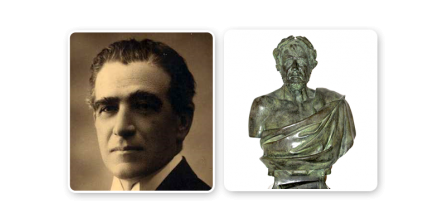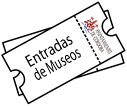
Bust of Séneca Audiodescription.

This work was made by Mateo Inurria, sculptor born in Córdoba in 1867. He studied at the Fine Arts School of Córdoba and he continued his studies in the Fine Arts School of San Fernando in Madrid. His works presented an impressive realism. His sculpture of Lucio Anneo Seneca getting the National Medal Award in 1895 is a reflection of this.
This bust of Seneca was sculpted in marble and is exhibited on a pedestal showing his name. He is wearing a cloth across his body leaving his right shoulder uncovered. He bears a laurel wreath on his head. This is a masterpiece of realism which is greatly expressive due to the stark contrast between light and dark. This is achieved thanks to the accentuated facial features. The figure displays a thick beard and short, soft, wavy locks of hair.
Lucio Anneo Seneca was born in Corduba —nowadays Córdoba— in the 1st century AD. His father was a Roman rhetorician called Marco (Lucio) Anneo, better known as Seneca the Elder
He was educated in Rome, where he received a broad education. He worked as a lawyer, and after being appointed quaestor, he joined the Roman senate. He was married twice, with Pompeii Paulina as his second wife.
His oratory qualities attracted the jealousy of Emperor Caligula who considered himself to be the best orator in the Empire. He avoided death because of he was suffering from tuberculosis. They thought that with his health problems they wouldn’t need to kill him, as they believed that the illness would do them the favour of sending him to Hades.
The work of Seneca was written between 50 and 60 AD. He wrote nine tragedies, among other works: Delirious Hercules, The Trojans, The Phoenicians, Medea, Phaedra, Oedipus, Agamemnon, Thyestes and Hercules in the Eta. He wrote also the drama Octavia and a series of Epigrams, although, their actual authorship remains uncertain.
After Agrippina the Elder was killed by his son, the emperor Nero, the artist moved out of the public life because he was scared that the emperor would have him killed because Agrippina had been his main defender. After becoming isolated from Roman public life, he started travelling with his wife to the south of the Italian Peninsula where he created one of his best works Epistolae morales ad Lucilium.
Sections of this piece:
Press the Play buttons to access a speech version of the description or the audiodescription for visually impaired.
Click in Audiodescription to access to its text version.

Alcazar of the Christian Monarchs. Plaza Campo Santo de los Mártires s/n. 14004 Córdoba
2011 Ayto. de Córdoba. All rights reserved. Legal Advice


